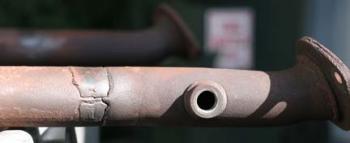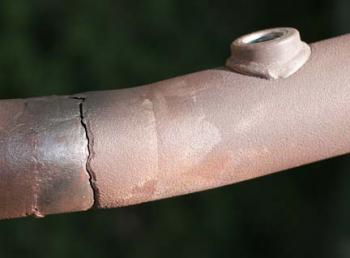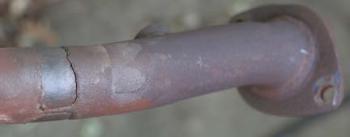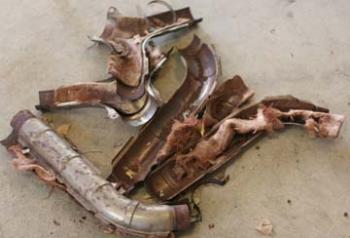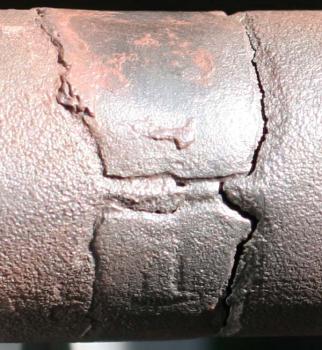-
Posts
1,299 -
Joined
-
Last visited
-
Days Won
7
Content Type
Profiles
Forums
Events
Gallery
Store
Articles
Videos
News & Articles
Everything posted by curiousB
-
I'd stop going to that dealer........
-
Update. In the end it was just a leaky pipe. See thread below for more detail. http://us.lexusownersclub.com/forums/index.php?showtopic=70886
-
Please tell me which one is 02 sensor. Thank you for all the help. Check for leak in pipe before or after secondary O2 sensor. I had that problem on LS430 and changed parts befoe I got the right answer. Welded pipe leaks shut and all is well.
-
Well my P0430 saga is over I think. Today I removed the Y pipe and secondary catalytic converter section to get it on the bench. I removed the stainless steel heat shields and sure enough on the Bank 2 side the pipe was cracked almost all the way around. The crack was about 6" behind the secondary O2 sensor hidden under the shield. See photos below. So I reinstalled the Y pipe with finger tight bolts just to get it aligned properly. Then I tack welded the pipe (MIG welder with flux core wire, no gas) so it would stay in the proper orientation. I then pulled the pipe back out and got it on the bench for a thorough welding. It’s really a job for a TIG welder but since I don’t have one I plodded on with my MIG welder. It isn’t a work of beauty but I got the pipe strengthened and plugged up of all the leaks. Then went on to puddle weld the other areas where the shield clamps had existed (and the exhaust pipe was about to corrode through). I figured while I was at it I might as well strengthen those areas. After I was done I didn’t reinstall the stainless steel heat shields (last photo at bottom) as the fiberglass insulation was damaged beyond use and some of the bumps from welding would have interfered with a proper fit. Maybe someday I’ll get ambitious and put them on but I doubt it’s anytime soon. I decided to remove the replacement non-OEM catalytic converter I installed back in August and reinstalled the old OEM one. Using new OEM gaskets and bolts throughout, reinstall was a snap. I had bought a new O2 sensor for the Bank 2 secondary side but didn’t install it either. I also didn’t use the O2 sensor spacers I had been experimenting with (spoofing emission system so it didn’t see erroneous bank 2 secondary O2 sensor). Fired up car and it was immediately more silent than before. Recently the leak had gotten to the point that it was becoming quite audible. Now it was back like it was before all this trouble. I went for a test drive with my OBDII adapter and laptop. I watched the bank 2 primary and secondary O2 sensors on a graph output. Lexus LS430 O2 Sensor Graphs.pdf I knew right away all my P0430 problems were fixed. The secondary O2 sensor was stable, mid voltage range and only moved a little. It closely mirrored the bank 1 secondary sensor. Prior to this the bank 2 secondary sensor tracked the bank 2 primary sensor. That is why I thought I had a bum catalytic converter. I’ve since driven 80 miles or so and no CEL. It might take a couple days to run all the ECU tests but I am very confident this has solved the problem due to the radical change in the bank 2 secondary sensor output after welding the leak. Lessons learned: This was never a failed catalytic converter problem as some suggested (DAY). I am very happy I didn’t buy a $1,000 OEM primary catalytic converter or $1300 OEM Y-pipe/secondary catalytic converter. I still don’t understand why a leak well after the second O2 sensor can have such a dramatic impact on secondary O2 sensor readings. While I don’t understand it, I have seen very clearly with leak and without (repaired) leak. The difference is unmistakable. I wasted some money on parts I didn’t need. $60 on a bank 2 primary O2 sensor, $175 non OEM catalytic converter, and another $60 on a secondary O2 sensor. I’ll leave the primary O2 sensor in as it’s not worth my time to pull it out. I’ll see if I can sell the slightly used converter and new unused secondary O2 sensor on eBay. The design of the Y pipe and secondary catalytic converter is poor. The stainless shield and salt water wicking insulation sets up a perfect corrosion environment for the exhaust pipe to develop leaks. I suspect a lot of LS430 owners will start seeing P0420 and P0430 error codes. My salty home state of IL contributed to my 2004 happening so fast. I learned a bit about OBDII and emission control system in general. Always use OEM gaskets when removing these parts. The gaskets that came with my non OEM catalytic converter were laughable. I made a listening device with 2’ of clear tubing connected to the ear piece of my mechanics stethoscope. It made probing for leaks simple and precise. In fact I found a couple pinhole leaks after I was done that I was able to plug up with a couple of MIG shots. If you get a P0420 or P0430 don’t run out and change catalytic converters. It may be as simple as a pipe crack underneath the stainless steel heat shields.
-
What makes you think it is "pinging" (knocking and pre ignition are two different phenomenon)? You need to be careful not to prematurely judge the problem before you jump to any solutions. That said if it truly is knocking(although I can't recall that complaint once on this forum) then it would might suggest fuel mix and/or ignition timing issues. There are knock sensors on the engine so maybe one has gone deaf and isn't detecting the ping and therefore not guiding the ECU algorithm to adjust. There are two such sensors, item 89615 in the diagram below. It is highly unlikely for two sensors to simultaneously fail, but which one? It could get expensive throwing parts at this in search for a solution.. I'm not sure the ECU's ability to diagnose the knock sensors but there are several OBDII codes for the knock sensors so its a bit strange you don't have a CEL and code or two stored. The other possibility is one of the two primary O2 sensors (the ones before the Catalytic converter). If it were sending a false signal to the ECU, fuel trim would be out of balance. You can check this by connecting an OBDII adapter and laptop and look at the O2 output signal on a graph. Some say O2 sensors have a useful life is 100k miles, after that they get contaminated and the signal output gets lazy (slower moving waveform). This leads to over and under correction of fuel trim since the feedback signal is too slow to react. O2 sensors are about $60-70 on eBay for OEM. Its DIY if you buy an O2 sensor wrench. Dealer will charge you $100+ just to look at them, in this case the soluion is about as expensive as the diagnosis. It could also be an airleak in the intake duct which is leaning out the fuel since that air bypasses the MAF. This would show up as an elevated long term fuel trim however since the O2 sensor feedback will attempt to correct the fuel mix problem. Again OBDII data is helpful to run this theory to ground. A very simple test is to go to a different place for gas with a top tier brand and premium grade.
-
Depends which sensor you have to change. The outer four (2 on each side) on the front corners do NOT need the bumper removed, you can loosen a cover and reach behind....
-
The only way you can sort this out is to get a digital voltmeter and make battery measurements with engine off, engine running but everything electrical turned off and then engine running with everything electrical switched on. Report back those readings and we can go from there. The battery reading needs to be at the battery posts not somewhere else in the circuit (negative terminal to postive terminal). Until you start taking measurements we're all just sitting around guessing.
-
It should be able to run with one coil. It won't sound pretty but it should be able to keep running. Are you saying it won't run with just one coil disconnected? Did you reconnect that one and then disconnect the other? Or did you just disconnect both? i.e. Coil A Coil B Test 1 both coils in car runs. Test 2 unplug Coil A see if car still runs. Test 3 plug Coil A back in and unplug Coil B. See if car runs. If Test 1 & 2 works but not test 3 then replace coil A If Test 1 & 3 works but not test 2 then replace coil B
-
Well I am still struggling. I fallen into the guilty trap of swapping parts. Forgive me for I have sinned.... I've replaced pre cat O2 sensor. Put in new bank 2 (non OEM) cat. and swapped rear O2 sensors bank 1->2 and 2->1. I experimented with O2 sensor spacers to spoof the ECU system (this did work, I stopped getting the P0430 but then got P0156 instead). I patched a small hole in Y pipe under SST shields with a muffler fiber tape product but that was a laughable fix. I really need the new Y pipe like you but the ebay version stops at 2003 and I'm a 2004..... OEM is >$1000.. Since the most of the parts are the same I'm almost temped to buy the 2003 Y Pipe like you and see if it will fit anyway. The CATs are the same PN. So I'm going to take one last crack at it this coming weekend. I've ordered all the bolts and gaskets and an going to reinstall the old (OEM) bank 2 cat with new gaskets. I'm going to pull of the whole Y pipe assembly and get it on the bench to see if I can get the holes welded or patched. and then re install. The new Y Pipe from ebay seems to come without the shields. Did you remove your shield and transfer then over or just not bother? Where I live salty roads are standard all winter. The glass insulation under the shield is just a moist sponge to hold that corrosive salty water (until it boils off, but leaves the salt behind). Seems a bad design. Also I don't know why they wouldn't have used SST for this pipe. It looks like your replacement one is SST. Makes you wonder why an OEM version for >$1,000 can't be as well made as a $300 aftermarket.... Glad to hear you're back in order. Let us know if a P0420/P0430 sneeks back. I still have trouble understanding why an exhaust leak AFTER the second O2 sensor can play havoc. It just seems that after the second O2 the car doesn't really know what is going on anymore. If someone can explain this I'd love to know. I've heard theories like back pressure and pulses sucking in air but I just picture the pipe always being above atmosphere pressure in my mind.
-

Project Beater With A Heater! ($500 Ls400)
curiousB replied to AirForceRacer's topic in 90 - 00 Lexus LS400
-
I hope I don't jinx myself but I'm 8 years in and 110k miles and still on the original bulbs. They might be expensive but they sure last a long time..... Not expensive when you consider full lifecycle cost...
-
Well I'd sure take a look at the exact code in the ECU before doing anything. This might confirm a simple fix or a costly black hole. I'm struggling with an emissions issue for a few weeks on my 2004. The three catalytic converters cost upwards of $3,000 as a set (for OEM) so if it I get a worst case solution its going to cost me a bundle.
-
You're in the running for "Champion of Lost Causes"
-
Well correlation in the face of large sample sizes makes a pretty compelling case. Fact; many LS400s with leaking PS pump also have alternator failures. Random mutually exclusive events? Or cause and effect. If it was only one or two complaints then maybe you can be dismissive. At some point thought the volume of the failures and the clear correlation is saying something even if you don't want to hear it. Anyway make your own opinion. I have a 2004 so don't have a dog in this race. As my kids say, whateva....
-
Your experience may be different but there are about 100 or more cases of PS fluid causing the rotor brushes to wear prematurely on this forum. There are even threads for cockamamie alternator covers instead of fixing the root cause leak. Urban legend...., the facts are quite clear. As for the TB that is a personal call. It’s also a lot less of a card to play if you are a non interference engine. A snapped belt is just a tow and a day or two inconvenience. On an interference it can be $5k+ and/or a complete write off of the car. So if you have an interference engine and you push the TB to 200k miles it’s not a ringing endorsement of a person’s good judgment. I changed my water pump when I did my TB to be prudent and because there we signs of seal leakage at the weep hole (the pink antifreeze leave an unmistakable stain). It is an extra $98 for OEM WP or $69 for non OEM. I would say the extra cost is trivial compared to the time and effort to get at the TB.
-
I replaced one of the rusty shield clamps with a 2" stainless steel plumbing gear clamp. Worked well enough to hold shield. Inexpensive too. I wouldn't bother with a drain hole in the shield. That pipe gets so hot when you run car any moisture in the mineral wool will quickly boil off. Probably with a couple minutes of running engine. I did find the faces of the Y pipe flanges and the mating side on the converter had pockets of corrosion. Now you'll be replacing one side (new flange) to pristene but the other may have some wear spots. Lexus gaskets seem to require a smooth face to compress against. Hopefully you'll get a tight fit. Keep us posted if the new Y pipe makes the codes go away.
-
Lets just agree to disagree on this one. I am 99.999% certain the shield (and the mineral wool insulation under it) is there to stop the exhaust from cooling so the secondary Catalytic Converter can reach "light off" temperature. Bare uninsulated pipe will cause cooling and delay the secondary converter from kicking in. I agree there is no pressure sensor but O2 sensors aren't temperature sensors either. They measure the amount of O2 in the exhaust stream. http://en.wikipedia.org/wiki/Oxygen_sensor It could be the leak stops the sensor from getting to 600° F it needs to function (that's why the sensor has a heater to speed up getting to temp so the engine can jump over to closed loop EFI) but I think it is more likely due to concentration of O2 in the gas after an exhaust pulse pushes through. For a moment it creates a short backdraft (vacuum in the pipe) and O2 is pulled into the pipe and potentially fools the sensor. Anyway there are plenty of posts about the need for this "plumbing" too be airtight so I think a trip to the muffler shop is in order.
-
I have been struggling with this one myself. I have same pin hole leaks on the Y pipe just under shield. I think electrolysis from dissimilar metals (shield is stainless steel pipe is steel). Poor design. Even entry level Chryslers have stainless steel exhaust pipe. Not sure why Lexus cheaped out here. I think the shields exist to retain heat in the pipe. This way the secondary catalytic converter gets up to temperature (known as the "light off" temperature)and functions properly. Unfortunately my 2004 Y pipe isn’t available from after market guys yet.... Only 2003 and earlier. Is $1000 from dealer. Since they tacked on the secondary Catalytic Converter to it the pipe is pricier than it needed to be.. What is odd to me is that a ) The leak is after the secondary O2 sensor so hard to see why it matters b ) The exhaust is under positive pressure, the notion of air leaking into the pipe seems impossible if the pipe is positive preesure. Some of my threads on this saga..... http://us.lexusownersclub.com/forums/index.php?showtopic=70141 http://www.clublexus.com/forums/ls430/580075-p0104-then-a-p0430-two-days-later.html
-
My P0430 code saga continues. I replaced the Catalytic Converter with one from eBay for $175. Seemed to improve the secondary O2 signal a little but still popped P0430 codes. Just checked the under hood label and see the OE CATs are California compliant. Maybe this explains why the cheaper 49 state CAT doesn't do its job and maybe why the OEM CATs are $1,000 per. Also the algorithm in the ECU to determine P0430 is maybe expecting a California compliant CAT. I have a couple of pinhole leaks a few inches past the second O2 sensor where the pipe has corroded. Tried patching them with muffler band-aid but that was a laughable experiment. Since this Y pipe also has the third CAT it is expensive for OE version >$1,100.... Maybe I'll take it to a muffler shop and have them weld some patches on the holes if the pipe is sound otherwise. Have been experimenting with spacing the secondary O2 sensor with spacers. http://www.clublexus.com/forums/ls430/580075-p0104-then-a-p0430-two-days-later.html I expect this will stop the P0430 codes but will maybe kick out a new error.
-
While working on my car I noticed some cracking in the lower arm bushings. Red arrow in the diagram. I can't tell if the tears go all the way through. Wondering if these are the bushings everyone is talking about on the forum. Also how bad is bad enough to bother replacing them?
-
Well since it's not April 1st I'll assume this was a serious post. Let's think about it. Car sit in sun. Internal temp reaches 120+ degrees. All items in cabin warm to that temperature. Owner jumps in. Turns on AC and air cools off in 1-2 minutes. Steel steering column and key mechanism stay the 120+ degrees for quite some time due to thermal mass and "insulation factor" of plastic coverings. Heat transfers efficient to metal key blade. Mystery solved....
-

96 Ls400 Bad Gas Mileage! Tried Everything
curiousB replied to yotoy82's topic in 90 - 00 Lexus LS400
Too many generalities and not enough hard data to conclude anything. You need to do a full tank MPG calculation on normal city driving (not parked and idling for long periods). Regular day to day driving. You need to confirm if you have dragging brakes or not. Comments like it seems to be fine and it coasts forever are simple generalizations. Outside ambient temperature is also irrelevant. The brakes will be 300-400+ degrees if they are dragging. The difference between 65 and 99 degrees ambient is nothing compared to 400 degrees. The vacuum leak theory would show up in your fuel trims. The car would have long term fuel trim elevated to compensate for the leaning of the engine causes by a vacuum leak. You said trims were fine. -
You can rebuild the pump with new seals. At dealer labor rates I think its cheaper to put in a new or rebuilt unit though. http://www.lexls.com/tutorials/steering/pspumprebuild.html
-
- Could be a bad battery with a dead cell or two causing the alternator to work too hard to try to recover it. Measure battery voltage with car not running at the terminal posts. Should be around 12- 12.5 VDC. Then turn on headlights with car not running and see what battery voltage is. Should drop a little but not more than a volt or two. - Could be a faulty regulator on the alternator trying to overcharge the battery. Measure battery voltage with car running and nothing electrical turned on. Should be around 13.3 VDC.



